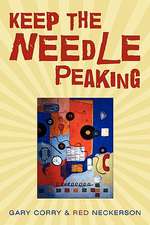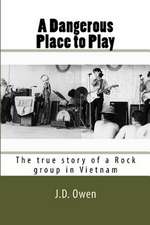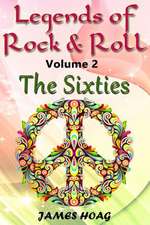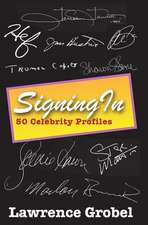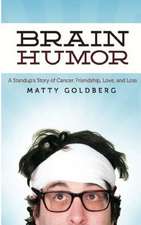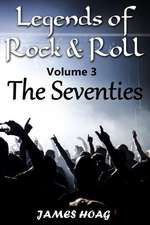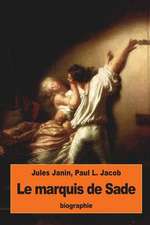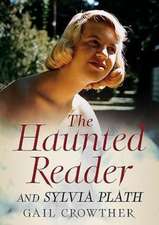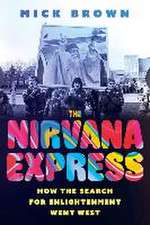Tearing Down the Wall of Sound: The Rise and Fall of Phil Spector
Autor Mick Brownen Limba Engleză Paperback – 30 apr 2008
Vezi toate premiile Carte premiată
Audies (2008)
| Toate formatele și edițiile | Preț | Express |
|---|---|---|
| Paperback (2) | 64.94 lei 3-5 săpt. | |
| Bloomsbury Publishing – 31 mar 2008 | 64.94 lei 3-5 săpt. | |
| Vintage Books USA – 30 apr 2008 | 106.42 lei 3-5 săpt. |
Preț: 106.42 lei
Nou
Puncte Express: 160
Preț estimativ în valută:
20.37€ • 22.11$ • 17.11£
20.37€ • 22.11$ • 17.11£
Carte disponibilă
Livrare economică 01-15 aprilie
Preluare comenzi: 021 569.72.76
Specificații
ISBN-13: 9781400076611
ISBN-10: 1400076617
Pagini: 484
Ilustrații: 8 PP. B&W
Dimensiuni: 134 x 204 x 27 mm
Greutate: 0.46 kg
Ediția:Reprint
Editura: Vintage Books USA
ISBN-10: 1400076617
Pagini: 484
Ilustrații: 8 PP. B&W
Dimensiuni: 134 x 204 x 27 mm
Greutate: 0.46 kg
Ediția:Reprint
Editura: Vintage Books USA
Notă biografică
Mick Brown was born in London in 1950 and has interviewed Salvador Dali, the Rolling Stones, James Brown, Don DeLillo, Richard Ford, Ravi Shankar, and the Dalai Lama, and has written several books as well on Richard Branson, the movie Performance, and a guide to America through pop songs. His interview with Spector--the first in twenty-five years--was published in The Telegraph in England only days before Lana Clarkson was found dead in his "castle" in Los Angeles.
Extras
Chapter 1: “Mr. Spector Likes People to Walk Up”
On an unseasonably warm day in December 2002 I found myself sitting in a room at the Hyatt Hotel on Sunset Strip in Los Angeles, waiting for Phil Spector to call.
It had been thirty-six hours since I’d arrived in Los Angeles, to find a message telling me that my meeting with Spector, which had taken some three months to arrange, and was scheduled to take place the following day, had been “postponed.” It was as if all my worst fears had come to pass.
Between 1961 and 1966, Spector’s so-called Wall of Sound made him the most successful pop-record producer in the world, with more than twenty Top 40 hits by such artists as the Crystals, the Ronettes and the Righteous Brothers. In the words of the writer Tom Wolfe, Spector was the “first tycoon of teen”—a mercurial and combustible mixture of genius and hustler, a precocious, brilliant and off-the-wall visionary who would change the face of pop music forever.
In a period when most people, even those who made it, regarded pop as disposable ephemera, Phil Spector alone dared to believe it could be art. Marshaling armies of guitars and keyboards and brass and drums, celestial sleighbells, and voices keening like angels, he made records of a hitherto unconceived-of grandeur and majesty, elevating the themes of teenage love and heartache to the epic proportions of Wagnerian opera—“little symphonies for the kids,” as he put it. Spector crammed emotion into a bottle and uncorked it—the clamorous, joyous noise of a small tyrant unleashing his vision, his revenge, on the world. When, in the late ’60s, musical fashion overtook his Wall of Sound, Spector moved on to the biggest pop group in the world, the Beatles. He rescued their valedictory album, Let It Be. He produced Imagine for John Lennon, and “My Sweet Lord” for George Harrison. Then began the long, slow retreat. In 1979 Spector produced his last album, for the punk rock group the Ramones. And then he was gone. The architect of the Wall of Sound vanished behind another wall—of barbed-wire fences, guard dogs and Keep Out: Armed Response signs, of stories about guns and craziness, rumor, half-truth and legend—much of it, it seemed, of Spector’s own creation. The “tycoon of teen” became rock and roll’s most enigmatic recluse.
When in the autumn of 2002 I first contacted Spector, he had not given a major interview in some twenty-five years, and to arrange a meeting involved delicate and protracted negotiations. Letters were dispatched back and forth. Michelle Blaine, Spector’s personal assistant, and the daughter of Hal Blaine, the drummer who had played on all of Spector’s greatest hits through the ’60s, happened to be passing through London, and we met for tea at a Mayfair hotel. She was fiercely protective of her employer. What exactly would be the thrust of the interview? Was I familiar with Mr. Spector’s records? How familiar? What had I read about Mr. Spector? I would be aware that there had been a great deal of misreporting about Mr. Spector’s life and affairs—gossip, scandal; talk of guns, of craziness—all of it exaggeration, myth and lies. Mr. Spector would not countenance any interview that proceeded along those lines.
A week later I was informed that Spector had agreed to talk. My elation was immediately tempered by a deep foreboding that the interview would almost certainly never happen. It was almost to be expected, then, that I should be told on my arrival in Los Angeles that our meeting had been “postponed.” I sat in my room, awaiting the call that I was now convinced would never come. And then the telephone rang. A car, I was informed, would be collecting me from my hotel at noon. At the appointed hour, a white 1965 Rolls-Royce Silver Cloud, license plate PHIL 500, drew up outside the hotel. A uniformed chauffeur held open the door. Encased in leather and walnut and hidden behind black curtains—a car that could tell stories—we turned onto the Hollywood Freeway, keeling slightly like some stately ocean liner, and headed east.
After some thirty minutes, we turned off the freeway, following the signs for Alhambra, a nondescript, working-class neighborhood of strip malls and scrubby bungalows. The road wound upwards, and further upwards still, ending at last at a set of high wrought-iron gates, posted with Keep Out signs. The chauffeur stepped out to open them, drove through and pulled to a halt at the bottom of a flight of stone steps, the gates closing behind us. “Mr. Spector,” he said, “likes people to walk up.” The steps led up through an avenue of lowering pines, the castle visible through the trees.
It was up these same steps that just a few weeks later, in the early hours of Monday, February 3, 2003, Spector would stagger with Lana Clarkson, a sometime actress and model, whom Spector had met just two hours earlier in a Hollywood nightclub. According to the testimony given to the police by Spector’s chauffeur Adriano De Souza—the same chauffeur who had driven me from my hotel—Spector was apparently inebriated, and Lana Clarkson was “like grabbing his arm and shoulder and helping him up the stairs.” Now, as I climbed, I had the distinct sense that I was being watched, although I might have been imagining this.
Michelle Blaine was waiting for me at the top. She led me through the front door into a cavernous hallway, wood-paneled and red-carpeted. Later, I would try to bring the details of this hall to mind, to match it with the account of the affidavit filed by Detective Mark Lillienfeld of the Los Angeles Sheriff’s Department, reporting the scene that he and other officers had found there in the early hours of February 3:
"Your affiant saw the victim slumped in a chair in the foyer of the home. She was wearing a black nylon slip/dress, black nylons, and black shoes. A leopard-print purse with a black strap was slung over her right shoulder, with the purse hanging down on her right side by her right arm. She had what appeared to be a single-entry gunshot wound to the mouth. Broken teeth from the victim were scattered about the foyer and an adjacent stairway. Lying under the victim’s left leg was a Colt, 2-inch, blue-steel, .38-caliber, six-shot revolver. This weapon had five live cartridges in the cylinder, and under the hammer, a spent cartridge."
I struggle to remember now exactly where in the hall that chair was placed. The affidavit makes no mention of the two suits of armor that I vividly recall, standing sentinel—stage props for a fantasy of baronial splendor. Spector was nowhere to be seen. Michelle Blaine led me on a tour of the ground-floor rooms. In the music room there was hi-fi equipment, and a guitar that had once belonged to John Lennon, resting on a stand, like a museum exhibit. A narrow room led off it, a bar lined with framed photographs of Spector with various music business luminaries.
In the sitting room a Picasso drawing hung on the wall beside an original John Lennon sketch. A uniformed maid brought iced water and I settled myself on a sofa beside a coffee table. The affidavit describes the scene that Detective Lillienfeld found in this room:
"In a living room just east of the foyer, your affiant saw that candles had been lit atop a fireplace mantel. The coffee table between two couches had a brandy glass partially filled with alcohol, and atop the table was a Jose Cuervo tequila bottle and a partially empty Canada Dry soft drink."
I waited, suddenly aware that classical music was eddying softly around the room. At length, Michelle Blaine’s mobile telephone rang. It was Spector, calling from elsewhere in the house. Phillip, she said, would be with us shortly. He appeared a few minutes later, walking down the staircase, to the strains of Handel. He was wearing a shoulder-length curled toupee, blue-tinted glasses, a black silk pajama suit with the monogram PS picked out in silver thread and three-inch Cuban-heel boots. He looked bizarre—like a wizened child in fancy dress—yet at the same time curiously magnificent. I rose from my seat to shake hands, and he peered up at me. “My,” he whispered. “You’re tall.”
He perched on the edge of a sofa, sipping from a tumbler filled with something that might have been cranberry juice, might have been anything. His hands trembled. Close up, his skin was sallow, like parchment, but his expression was puckish, amused. “I don’t like to talk,” he said. Yet over the next four hours, he talked like a man possessed. About his music, the Ronettes, the Righteous Brothers, the Beatles, about hustling and payola, success and failure.
“I knew,” he said. “People made fun of me, the little kid who was producing rock and roll records. But I knew. I would try to tell all the groups, we’re doing something very important. Trust me. And it was very difficult because these people didn’t have that sense of destiny. They didn’t know they were producing art that would change the world. I knew.”
“And you wanted immortality?”
“Yes. Very much. I think when Jefferson wrote the Declaration of Independence he was thinking, people will remember this. When Gershwin wrote, he may have said, ‘I don’t know about this American in Paris,’ but I think he said, ‘this is something special.’ I think Irving Berlin had an ego, that he wanted people to remember this. I think he wanted to be number one. And so did I.”
Our conversation was interrupted by a whirring noise, like a cuckoo clock, and a voice chirruping the hour. “It’s two o’clock.” His wristwatch. “Timing,” Spector said, “is the key to everything.
“Okay.” He jabbed a finger at me across the table. “You ask me, ‘What’s your name?’ And then you ask me, ‘What do you do for a living, and what’s the most important part of what you do for a living?’ Go ahead! Just for the conversation.”
“Okay. What’s your name?”
“Phil Spector.”
“And what do you do for a living?”
“I’m a record producer.”
“And what’s the most important—”
“Timing . . .” And he broke up in laughter.
I had not expected him to be funny. The scabrous comedian Lenny Bruce had been one of his closest friends—“my Socrates,” as Spector described him. And it was as if he was still keeping Bruce’s lines warm. “Profanity,” he said, “is the last refuge of the inarticulate prick.” And: “In a world where carpenters get resurrected, anything is fucking possible.” As long as you’ve got the timing right.
The wristwatch whirred and chirruped. “It’s three o’clock.” Time out. He rose from the sofa and vanished upstairs. I walked in the garden. The sun was shining on the roofs of the houses in the valley below. But among the trees, the unkempt lawn and flower beds, all was shadows and melancholy, and I wondered what could have brought Phil Spector here. Lunch was served in the dining room. I ate alone. When he returned, Spector looked at the food and shook his head. “Let’s go in the other room,” he said.
For years, he said, he had not been well. “I was crippled inside. Emotionally. Insane is a hard word, but it’s manic-depressive, bipolar. I take medication for schizophrenia, but I wouldn’t say I’m schizophrenic. But I have a bipolar personality, which is strange. I have devils inside that fight me. And I’m my own worst enemy.”
He had first started seeing a psychiatrist in 1960—to get out of the military draft, he said. He never stopped, but therapy was never enough. “There’s something I’d either not accepted, or I’m not prepared to accept or live with in my life, that I don’t know about perhaps, that I’m facing now.” He paused. “To all intents and purposes I would say I’m probably relatively insane, to an extent. To an extent. But I can function in the world.”
For years, he said, he couldn’t face being with people, and he couldn’t face being with himself. He suffered from chronic insomnia, night after night, going crazy. “You don’t sleep; your mind starts playing tricks on you. It’s a terrible situation.”
Finally, he sought help. Always “terrified” of drugs, he began taking medication that would moderate his moods and help him sleep. He had “waged war” with himself. “I just told myself that I would beat it. That I would beat my own brain. And over a slow period of time, and every day getting up and saying, no, you’re not there yet, and months and years going by . . .” He paused. “It’s been very slow, very difficult.”
Now, he said, he was trying to make his life “reasonable.”
“I’m not ever going to be happy. Happiness isn’t on. Because happiness is temporary. Unhappiness is temporary. Ecstasy is temporary. Orgasm is temporary. Everything is temporary. But being reasonable is an approach. And being reasonable with yourself. It’s very difficult, very difficult to be reasonable.” The wristwatch spoke. “It’s six o’clock.”
Six weeks after our meeting, on Saturday, February 1, 2003, my interview with Spector appeared in the Daily Telegraph magazine. He was pictured on the magazine’s cover in his Louis Quinze wig, grinning lopsidedly into the camera, looking like someone who’d taken too much Prozac. The headline was “Found: Pop’s Lost Genius.” Two days later, I was sitting in the office of the Telegraph magazine when a colleague burst in from the newsroom, telling me to turn on the television. It was 10:00 a.m., California time. Filmed from a helicopter’s perspective, the Alhambra castle resembled a Gothic film set, all turrets and dark pines. Cut to camera shots familiar from a hundred crime stories and cop shows: the yellow tape, the police prowl cars slewed in the drive, the stocky detectives in boxy suits moving purposefully around the grounds. An unidentified woman had been found, shot dead in Spector’s home. He was under arrest. For a terrible moment, a scene flashed across my mind. Somehow, Spector had read my piece, disliked it intensely, and in a moment of madness—“I have not been well . . .”—taken revenge on his assistant, Michelle Blaine. It was some hours before it would be revealed that the victim was Lana Clarkson. But who Lana Clarkson was, and what she was doing in Phil Spector’s castle in the early hours of February 3, it didn’t say.
Phil Spector was taken to Alhambra police station, where he was kept for some hours before being released from police custody on $1 million bail. It would be a further eight months before he was charged with murder, a full four years before he was to come to trial. In my interview with Spector, he had spoken with remarkable candor about his fragile mental state and his years on the brink of insanity. And in the wake of the shooting, his comments—“I have devils inside that fight me”—were recycled around the world, an instant template for his psychological condition. I received a telephone call from the Los Angeles Sheriff’s Department asking whether there was anything more I could tell them about his behavior on the day we met. There wasn’t. I had liked Spector when I met him and found it hard to believe he would kill anybody in cold blood. The coincidence of the article’s publication and Lana Clarkson’s death left me feeling shocked—in some curious way, implicated. I wrote to Spector to express my sympathy for the predicament he now found himself in, but heard nothing back. Nor did he reply when I wrote to inform him that I intended to write a book about his life and career and to request a further interview.
From the Hardcover edition.
On an unseasonably warm day in December 2002 I found myself sitting in a room at the Hyatt Hotel on Sunset Strip in Los Angeles, waiting for Phil Spector to call.
It had been thirty-six hours since I’d arrived in Los Angeles, to find a message telling me that my meeting with Spector, which had taken some three months to arrange, and was scheduled to take place the following day, had been “postponed.” It was as if all my worst fears had come to pass.
Between 1961 and 1966, Spector’s so-called Wall of Sound made him the most successful pop-record producer in the world, with more than twenty Top 40 hits by such artists as the Crystals, the Ronettes and the Righteous Brothers. In the words of the writer Tom Wolfe, Spector was the “first tycoon of teen”—a mercurial and combustible mixture of genius and hustler, a precocious, brilliant and off-the-wall visionary who would change the face of pop music forever.
In a period when most people, even those who made it, regarded pop as disposable ephemera, Phil Spector alone dared to believe it could be art. Marshaling armies of guitars and keyboards and brass and drums, celestial sleighbells, and voices keening like angels, he made records of a hitherto unconceived-of grandeur and majesty, elevating the themes of teenage love and heartache to the epic proportions of Wagnerian opera—“little symphonies for the kids,” as he put it. Spector crammed emotion into a bottle and uncorked it—the clamorous, joyous noise of a small tyrant unleashing his vision, his revenge, on the world. When, in the late ’60s, musical fashion overtook his Wall of Sound, Spector moved on to the biggest pop group in the world, the Beatles. He rescued their valedictory album, Let It Be. He produced Imagine for John Lennon, and “My Sweet Lord” for George Harrison. Then began the long, slow retreat. In 1979 Spector produced his last album, for the punk rock group the Ramones. And then he was gone. The architect of the Wall of Sound vanished behind another wall—of barbed-wire fences, guard dogs and Keep Out: Armed Response signs, of stories about guns and craziness, rumor, half-truth and legend—much of it, it seemed, of Spector’s own creation. The “tycoon of teen” became rock and roll’s most enigmatic recluse.
When in the autumn of 2002 I first contacted Spector, he had not given a major interview in some twenty-five years, and to arrange a meeting involved delicate and protracted negotiations. Letters were dispatched back and forth. Michelle Blaine, Spector’s personal assistant, and the daughter of Hal Blaine, the drummer who had played on all of Spector’s greatest hits through the ’60s, happened to be passing through London, and we met for tea at a Mayfair hotel. She was fiercely protective of her employer. What exactly would be the thrust of the interview? Was I familiar with Mr. Spector’s records? How familiar? What had I read about Mr. Spector? I would be aware that there had been a great deal of misreporting about Mr. Spector’s life and affairs—gossip, scandal; talk of guns, of craziness—all of it exaggeration, myth and lies. Mr. Spector would not countenance any interview that proceeded along those lines.
A week later I was informed that Spector had agreed to talk. My elation was immediately tempered by a deep foreboding that the interview would almost certainly never happen. It was almost to be expected, then, that I should be told on my arrival in Los Angeles that our meeting had been “postponed.” I sat in my room, awaiting the call that I was now convinced would never come. And then the telephone rang. A car, I was informed, would be collecting me from my hotel at noon. At the appointed hour, a white 1965 Rolls-Royce Silver Cloud, license plate PHIL 500, drew up outside the hotel. A uniformed chauffeur held open the door. Encased in leather and walnut and hidden behind black curtains—a car that could tell stories—we turned onto the Hollywood Freeway, keeling slightly like some stately ocean liner, and headed east.
After some thirty minutes, we turned off the freeway, following the signs for Alhambra, a nondescript, working-class neighborhood of strip malls and scrubby bungalows. The road wound upwards, and further upwards still, ending at last at a set of high wrought-iron gates, posted with Keep Out signs. The chauffeur stepped out to open them, drove through and pulled to a halt at the bottom of a flight of stone steps, the gates closing behind us. “Mr. Spector,” he said, “likes people to walk up.” The steps led up through an avenue of lowering pines, the castle visible through the trees.
It was up these same steps that just a few weeks later, in the early hours of Monday, February 3, 2003, Spector would stagger with Lana Clarkson, a sometime actress and model, whom Spector had met just two hours earlier in a Hollywood nightclub. According to the testimony given to the police by Spector’s chauffeur Adriano De Souza—the same chauffeur who had driven me from my hotel—Spector was apparently inebriated, and Lana Clarkson was “like grabbing his arm and shoulder and helping him up the stairs.” Now, as I climbed, I had the distinct sense that I was being watched, although I might have been imagining this.
Michelle Blaine was waiting for me at the top. She led me through the front door into a cavernous hallway, wood-paneled and red-carpeted. Later, I would try to bring the details of this hall to mind, to match it with the account of the affidavit filed by Detective Mark Lillienfeld of the Los Angeles Sheriff’s Department, reporting the scene that he and other officers had found there in the early hours of February 3:
"Your affiant saw the victim slumped in a chair in the foyer of the home. She was wearing a black nylon slip/dress, black nylons, and black shoes. A leopard-print purse with a black strap was slung over her right shoulder, with the purse hanging down on her right side by her right arm. She had what appeared to be a single-entry gunshot wound to the mouth. Broken teeth from the victim were scattered about the foyer and an adjacent stairway. Lying under the victim’s left leg was a Colt, 2-inch, blue-steel, .38-caliber, six-shot revolver. This weapon had five live cartridges in the cylinder, and under the hammer, a spent cartridge."
I struggle to remember now exactly where in the hall that chair was placed. The affidavit makes no mention of the two suits of armor that I vividly recall, standing sentinel—stage props for a fantasy of baronial splendor. Spector was nowhere to be seen. Michelle Blaine led me on a tour of the ground-floor rooms. In the music room there was hi-fi equipment, and a guitar that had once belonged to John Lennon, resting on a stand, like a museum exhibit. A narrow room led off it, a bar lined with framed photographs of Spector with various music business luminaries.
In the sitting room a Picasso drawing hung on the wall beside an original John Lennon sketch. A uniformed maid brought iced water and I settled myself on a sofa beside a coffee table. The affidavit describes the scene that Detective Lillienfeld found in this room:
"In a living room just east of the foyer, your affiant saw that candles had been lit atop a fireplace mantel. The coffee table between two couches had a brandy glass partially filled with alcohol, and atop the table was a Jose Cuervo tequila bottle and a partially empty Canada Dry soft drink."
I waited, suddenly aware that classical music was eddying softly around the room. At length, Michelle Blaine’s mobile telephone rang. It was Spector, calling from elsewhere in the house. Phillip, she said, would be with us shortly. He appeared a few minutes later, walking down the staircase, to the strains of Handel. He was wearing a shoulder-length curled toupee, blue-tinted glasses, a black silk pajama suit with the monogram PS picked out in silver thread and three-inch Cuban-heel boots. He looked bizarre—like a wizened child in fancy dress—yet at the same time curiously magnificent. I rose from my seat to shake hands, and he peered up at me. “My,” he whispered. “You’re tall.”
He perched on the edge of a sofa, sipping from a tumbler filled with something that might have been cranberry juice, might have been anything. His hands trembled. Close up, his skin was sallow, like parchment, but his expression was puckish, amused. “I don’t like to talk,” he said. Yet over the next four hours, he talked like a man possessed. About his music, the Ronettes, the Righteous Brothers, the Beatles, about hustling and payola, success and failure.
“I knew,” he said. “People made fun of me, the little kid who was producing rock and roll records. But I knew. I would try to tell all the groups, we’re doing something very important. Trust me. And it was very difficult because these people didn’t have that sense of destiny. They didn’t know they were producing art that would change the world. I knew.”
“And you wanted immortality?”
“Yes. Very much. I think when Jefferson wrote the Declaration of Independence he was thinking, people will remember this. When Gershwin wrote, he may have said, ‘I don’t know about this American in Paris,’ but I think he said, ‘this is something special.’ I think Irving Berlin had an ego, that he wanted people to remember this. I think he wanted to be number one. And so did I.”
Our conversation was interrupted by a whirring noise, like a cuckoo clock, and a voice chirruping the hour. “It’s two o’clock.” His wristwatch. “Timing,” Spector said, “is the key to everything.
“Okay.” He jabbed a finger at me across the table. “You ask me, ‘What’s your name?’ And then you ask me, ‘What do you do for a living, and what’s the most important part of what you do for a living?’ Go ahead! Just for the conversation.”
“Okay. What’s your name?”
“Phil Spector.”
“And what do you do for a living?”
“I’m a record producer.”
“And what’s the most important—”
“Timing . . .” And he broke up in laughter.
I had not expected him to be funny. The scabrous comedian Lenny Bruce had been one of his closest friends—“my Socrates,” as Spector described him. And it was as if he was still keeping Bruce’s lines warm. “Profanity,” he said, “is the last refuge of the inarticulate prick.” And: “In a world where carpenters get resurrected, anything is fucking possible.” As long as you’ve got the timing right.
The wristwatch whirred and chirruped. “It’s three o’clock.” Time out. He rose from the sofa and vanished upstairs. I walked in the garden. The sun was shining on the roofs of the houses in the valley below. But among the trees, the unkempt lawn and flower beds, all was shadows and melancholy, and I wondered what could have brought Phil Spector here. Lunch was served in the dining room. I ate alone. When he returned, Spector looked at the food and shook his head. “Let’s go in the other room,” he said.
For years, he said, he had not been well. “I was crippled inside. Emotionally. Insane is a hard word, but it’s manic-depressive, bipolar. I take medication for schizophrenia, but I wouldn’t say I’m schizophrenic. But I have a bipolar personality, which is strange. I have devils inside that fight me. And I’m my own worst enemy.”
He had first started seeing a psychiatrist in 1960—to get out of the military draft, he said. He never stopped, but therapy was never enough. “There’s something I’d either not accepted, or I’m not prepared to accept or live with in my life, that I don’t know about perhaps, that I’m facing now.” He paused. “To all intents and purposes I would say I’m probably relatively insane, to an extent. To an extent. But I can function in the world.”
For years, he said, he couldn’t face being with people, and he couldn’t face being with himself. He suffered from chronic insomnia, night after night, going crazy. “You don’t sleep; your mind starts playing tricks on you. It’s a terrible situation.”
Finally, he sought help. Always “terrified” of drugs, he began taking medication that would moderate his moods and help him sleep. He had “waged war” with himself. “I just told myself that I would beat it. That I would beat my own brain. And over a slow period of time, and every day getting up and saying, no, you’re not there yet, and months and years going by . . .” He paused. “It’s been very slow, very difficult.”
Now, he said, he was trying to make his life “reasonable.”
“I’m not ever going to be happy. Happiness isn’t on. Because happiness is temporary. Unhappiness is temporary. Ecstasy is temporary. Orgasm is temporary. Everything is temporary. But being reasonable is an approach. And being reasonable with yourself. It’s very difficult, very difficult to be reasonable.” The wristwatch spoke. “It’s six o’clock.”
Six weeks after our meeting, on Saturday, February 1, 2003, my interview with Spector appeared in the Daily Telegraph magazine. He was pictured on the magazine’s cover in his Louis Quinze wig, grinning lopsidedly into the camera, looking like someone who’d taken too much Prozac. The headline was “Found: Pop’s Lost Genius.” Two days later, I was sitting in the office of the Telegraph magazine when a colleague burst in from the newsroom, telling me to turn on the television. It was 10:00 a.m., California time. Filmed from a helicopter’s perspective, the Alhambra castle resembled a Gothic film set, all turrets and dark pines. Cut to camera shots familiar from a hundred crime stories and cop shows: the yellow tape, the police prowl cars slewed in the drive, the stocky detectives in boxy suits moving purposefully around the grounds. An unidentified woman had been found, shot dead in Spector’s home. He was under arrest. For a terrible moment, a scene flashed across my mind. Somehow, Spector had read my piece, disliked it intensely, and in a moment of madness—“I have not been well . . .”—taken revenge on his assistant, Michelle Blaine. It was some hours before it would be revealed that the victim was Lana Clarkson. But who Lana Clarkson was, and what she was doing in Phil Spector’s castle in the early hours of February 3, it didn’t say.
Phil Spector was taken to Alhambra police station, where he was kept for some hours before being released from police custody on $1 million bail. It would be a further eight months before he was charged with murder, a full four years before he was to come to trial. In my interview with Spector, he had spoken with remarkable candor about his fragile mental state and his years on the brink of insanity. And in the wake of the shooting, his comments—“I have devils inside that fight me”—were recycled around the world, an instant template for his psychological condition. I received a telephone call from the Los Angeles Sheriff’s Department asking whether there was anything more I could tell them about his behavior on the day we met. There wasn’t. I had liked Spector when I met him and found it hard to believe he would kill anybody in cold blood. The coincidence of the article’s publication and Lana Clarkson’s death left me feeling shocked—in some curious way, implicated. I wrote to Spector to express my sympathy for the predicament he now found himself in, but heard nothing back. Nor did he reply when I wrote to inform him that I intended to write a book about his life and career and to request a further interview.
From the Hardcover edition.
Recenzii
“Fascinating, detailed. . . . A great portrait of where genius and madness meet.”—Rocky Mountain News “Bloodcurdling biography. . . . A portrait of pure self-interest and cruelty, tempered only slightly by the great musical achievements of Mr. Spector's golden age in the early 1960s.” —The New York Times“A bruising portrait of legendary music producer Phil Spector.” —Entertainment Weekly“Gripping. . . . Brown succeeds in providing a well-rounded portrait of someone the public never understood. And it comes at just the right time, too-when they're asking more questions about him than ever.” —The Washington Post
Premii
- Audies Finalist, 2008





